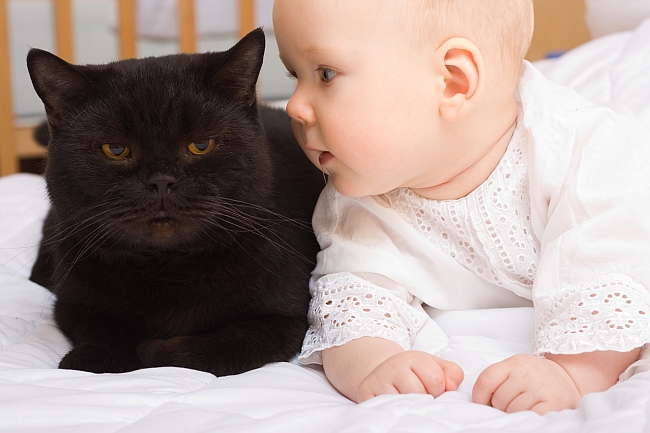
There seems to be an idea that cats and newborn babies do not mesh well. The apparent vulnerability of a newborn child and the seeming unpredictability of a cat make for various concerns about whether or not it is safe for babies to be around the family feline. While leaving a helpless child unsupervised by any animal does pose a certain hazard, studies have shown that children who are raised around pets actually have stronger immune systems and are less likely to develop allergies than children who do not. Both a pet cat and an infant can live peacefully and safely in the same home together, provided that certain precautions and boundaries be established.
Rules for Cats and Infants
- Always supervise their interactions. When a new person is brought into the home, it is natural for a cat to be interested in them. The kitty might sniff around the baby blankets, diaper bag, and even cuddle up to you while the baby is nursing. This is absolutely fine as long as an adult is present to make sure nothing happens to the baby, if the cat starts getting a little too curious.
- Do not let the cat in the crib. While this might go without saying, some pet owners are not opposed to letting their pets nap next to their babies. This is not advisable as the cat might swat at the child and accidentally scratch or nip it, if the baby were to roll around or accidentally wave its arms in the cat’s face. This would not only be uncomfortable, but it could also subject the child to diseases and infections.
Note that it is a myth that cats will try to suck the breath out of the baby. Usually if a cat’s face is near an infant’s, it is either because the baby is warm, or because he smells like milk and the cat is simply checking it out. - Set some house boundaries. If you do not want to cat hopping up on the changing table, and would like him away from the baby’s books, toys and blankets, review some of these ways to keep your kitty at bay. Some pet owners also attach adjustable pet gates, or screen doors to their nursery, so that the cat can see where you are without being allowed to come in.
- Be warned: Even healthy, well-maintained cats can carry diseases. Some felines carry diseases in their saliva and under their nails, which can prove very dangerous to young children if they are scratched or bitten even playfully. Toxoplasmosis is disease caused by parasites that can be passed through an animal’s fecal matter. Because cats use litter boxes, their paws may come into contact with this bacteria. Toxoplasmosis is a threat to expectant mothers (as it can lead to miscarriage, birth defects, blindness, etc.) and is also harmful to newborns. Other diseases that can be passed from cats: are Salmonella, rabies (if the cat is unvaccinated), and ringworm, etc.
- Maintain some kitty-time. To create positive dynamics between a pet and a baby, make sure not to neglect your cat. When the baby is napping, cuddle up with your feline pal, or be sure to pet her constantly throughout the day. This will make the cat feel less threatened about there being a new-comer around.

